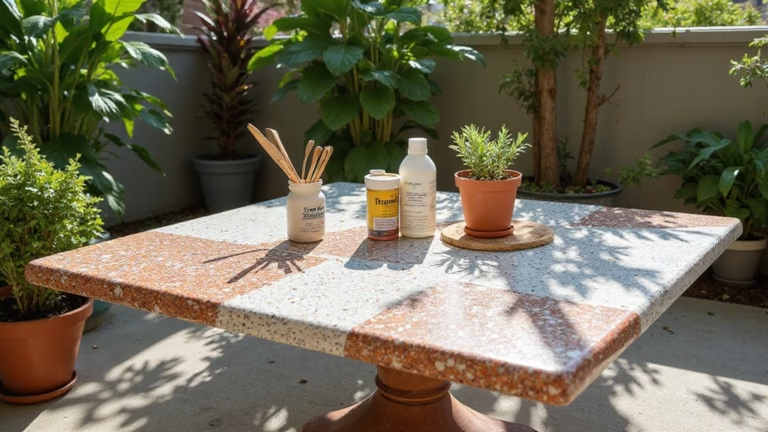As the summer sun blazes down, keeping your home cool without cranking up the air conditioning can seem like a challenge.
Fear not! With some creative eco-cooling tips, you can embrace natural ventilation and DIY shade screens that not only save energy but also add character to your home.
Get ready to explore stunning ways to keep your space comfortable while being kind to the planet. Each tip is designed to be visually appealing and easy to implement, making your home a refreshing haven this summer.
1. Embrace Cross-Ventilation

One of the simplest ways to cool your home is through cross-ventilation.
By strategically opening windows on opposite sides of your home, you can create a delightful breeze that flows through your living space, pushing out hot air and bringing in cooler air. This natural cooling method not only reduces reliance on air conditioning but also enhances indoor air quality.
Here are some tips to maximize cross-ventilation:
– Timing is key: Open windows during the cooler parts of the day, such as early morning or late evening.
– Use fans: Place box fans in windows to help pull in the cool air and push out warm air.
– Position furniture wisely: Ensure that your furniture doesn’t block airflow from windows and doors.
Incorporating cross-ventilation can also add an aesthetic touch to your home. Consider using lightweight, sheer curtains that flow with the breeze, adding a sense of movement and charm to your decor.
This technique not only cools but also brings the beauty of the outdoors inside, creating a serene atmosphere perfect for relaxation.
For cross-ventilation, you might want to invest in:
– Energy-efficient box fans
– Sheer curtains for windows
– Decorative window screens to enhance airflow without compromising style.
2. Create DIY Shade Screens

DIY shade screens are a fantastic way to block out the harsh rays of the sun while still letting in natural light.
These screens can be made from various materials and customized to fit any window size, adding a unique touch to your home decor. Not only do they keep your space cooler, but they also protect your furniture and flooring from fading.
Here’s how to create your own DIY shade screens:
– Materials Needed: Choose from bamboo, fabric, or even recycled materials like old sheets.
– Measure and Cut: Measure your window dimensions and cut your material accordingly.
– Mounting: Use simple brackets or adhesive hooks to attach your shade to the window frame.
– Decoration: Add personal flair by painting or stenciling designs on fabric shades.
The beauty of DIY shade screens is that they can be both functional and stylish. By selecting colors and patterns that complement your home’s decor, you can enhance your living space while keeping it cool.
For your DIY shade screens, consider these products:
– Roll-up bamboo shades
– Fabric in fun prints or colors
– Mounting brackets and adhesive hooks.
3. Utilize Natural Landscaping

Landscaping isn’t just for aesthetics; it plays a crucial role in cooling your home naturally.
Strategically placed trees and shrubs can provide shade, reduce heat gain, and improve air quality. By planting leafy trees near sunny windows, you can significantly lower indoor temperatures during the hottest parts of the day.
Here are some landscaping tips to maximize cooling:
– Choose the Right Plants: Opt for native plants that thrive in your climate and provide ample shade.
– Create Windbreaks: Use taller trees or shrubs to block cold winds in winter while allowing for cooling breezes in summer.
– Consider Green Roofs: If you’re feeling adventurous, a green roof covered with vegetation can drastically reduce heat absorption and create a natural insulation layer.
Utilizing natural landscaping not only enhances your home’s beauty but also contributes to eco-friendliness. It encourages wildlife, improves air quality, and ultimately creates a peaceful outdoor retreat.
To enhance your landscaping, consider:
– Native trees and shrubs for your area
– Garden tools for planting and maintenance
– Mulch to retain soil moisture and suppress weeds.
4. Install Roof Overhangs

Roof overhangs are an excellent architectural solution to combat heat.
By extending the roofline beyond the walls of your home, you create shaded areas that protect windows from direct sunlight, thus keeping your interiors cooler. This simple yet effective design can reduce cooling costs significantly.
Here’s how roof overhangs help:
– Reduce Solar Gain: By blocking out the sun’s rays during peak hours, overhangs limit the amount of heat that enters your home.
– Enhance Aesthetics: Overhangs can add character and style to your home’s exterior, complementing various architectural designs.
– Rain Protection: They also provide shelter from rain, keeping your entryways dry and welcoming.
Incorporating roof overhangs can be done during new construction or as a retrofitting project. They are an investment in energy efficiency and comfort, combining functionality with beauty.
Consider these products for your roof overhang project:
– Pre-cut overhang kits
– Weather-resistant materials for durable construction
– Paint or stain to match your home’s decor.
5. Utilize Cooling Tiles

Cooling tiles are an innovative solution for maintaining a comfortable temperature indoors.
These specially designed tiles reflect sunlight and keep surfaces cooler, making a noticeable difference in heat absorption. Ideal for outdoor patios, sunrooms, or even indoors, cooling tiles can enhance your home’s comfort while adding a modern touch.
Here’s why you should consider cooling tiles:
– Energy Efficiency: They reduce the need for air conditioning, saving you money on energy bills.
– Stylish Options: Available in various colors and patterns, these tiles can complement any decor style.
– Durable and Long-lasting: Made from weather-resistant materials, cooling tiles are designed to withstand the elements.
Installing cooling tiles can transform your space into a cool oasis, especially during the hottest summer months. They not only look great but also contribute to a more sustainable lifestyle.
Consider adding:
– Cooling patio tiles for outdoor spaces
– Indoor cooling tiles for sunrooms
– Installation tools for DIY enthusiasts.
6. Install Ceiling Fans

Ceiling fans are a classic solution to beat the heat while adding style to your home.
They help circulate cool air, making a room feel more comfortable without the need for air conditioning. Modern ceiling fans come in a variety of designs, making them a decorative feature in any room.
Here’s how to choose and use ceiling fans effectively:
– Size Matters: Select a fan that fits the size of your room; larger spaces need bigger fans.
– Direction: Make sure to set your fan to rotate counterclockwise in summer, pushing cool air down.
– Placement: Install fans in high-traffic areas like living rooms and patios for maximum benefit.
In addition to functionality, ceiling fans can enhance your decor. With so many styles available, from rustic wood to sleek modern designs, you can find the perfect fan to complement your home’s aesthetic.
Consider these options:
– Energy-efficient ceiling fans
– Stylish ceiling fan designs
– Remote controls for convenience.
7. Add Indoor Plants

Indoor plants are not just beautiful; they also serve as natural air coolers.
Plants like peace lilies, snake plants, and ferns release moisture into the air, helping to lower temperatures while improving air quality. Incorporating greenery into your decor not only enhances visual appeal but also contributes to a healthier living environment.
Here’s how to maximize the cooling effects of indoor plants:
– Choose Wisely: Select plants that thrive in your indoor environment and are easy to care for.
– Group Plants Together: Cluster plants to create a microclimate that enhances humidity and cooling effects.
– Position Strategically: Place plants near windows where they can benefit from natural light.
The combination of visual beauty and cooler air makes indoor plants a must-have for any eco-friendly home. They create a serene atmosphere and enhance your decor style.
For your indoor plant collection, consider:
– Easy-care indoor plants like snake plants or pothos
– Decorative pots for style
– Plant care tools for maintenance.
8. Use Reflective Window Films

Reflective window films are a smart and effective way to reduce heat gain in your home.
These films reflect sunlight, preventing it from entering your home and keeping your interiors cooler. They are easy to apply and come in a variety of styles, enhancing your home’s energy efficiency while maintaining privacy.
Here’s why you should consider reflective window films:
– Cost-effective: They are a cheaper alternative to window replacements and can be installed easily.
– UV Protection: Reflective films block harmful UV rays, protecting your furniture and flooring from fading.
– Privacy with Style: Many films offer one-way visibility, allowing you to enjoy your view while keeping prying eyes out.
Using reflective films can be a stylish solution that complements your home’s aesthetics. Choose designs that match your decor while providing practical benefits.
For reflective window film projects, consider:
– Solar control window films
– Decorative window films for added style
– Installation kits for easy application.
9. Implement Natural Cooling Techniques

Natural cooling techniques can work wonders for your home during hot days.
These methods rely on simple principles of physics to cool your living spaces without the need for air conditioning. Techniques such as ventilation, shading, and thermal mass can help create a comfortable environment.
Here are some natural cooling techniques to consider:
– Use Thermal Mass: Incorporate materials like stone or brick that absorb heat during the day and release it at night.
– Install Ventilation Systems: Natural ventilation systems allow for airflow without mechanical help, creating a more comfortable atmosphere.
– Create Shaded Areas: Utilize awnings, pergolas, or natural shade from trees to keep your home cooler.
Incorporating these techniques allows you to maintain a comfortable home while being eco-friendly. They not only save energy but also contribute to a healthier living environment.
For implementing natural cooling techniques, consider:
– Stone or brick materials for thermal mass
– Ventilation fans and systems
– Awnings or pergolas for shading.
10. Optimize Your Home’s Insulation

Good insulation plays a crucial role in maintaining a comfortable temperature in your home.
Proper insulation keeps the heat out during summer and traps warmth during winter, enhancing energy efficiency. By optimizing your home’s insulation, you can significantly reduce cooling costs.
Here are some tips to improve your insulation:
– Seal Leaks: Check for gaps around windows and doors, sealing them with weatherstripping or caulk.
– Upgrade Insulation: Consider adding insulation to your attic, walls, or floors for better temperature regulation.
– Use Reflective Barriers: Installing reflective barriers can help reduce heat absorption in your home.
Investing in insulation not only improves your home’s comfort but also contributes to sustainability. It reduces energy consumption, making your space eco-friendly.
For insulation projects, consider:
– Weatherstripping kits
– Insulation materials for walls or attics
– Reflective barriers for added efficiency.
11. Create Outdoor Living Spaces

Outdoor living spaces provide a refreshing escape from the heat while enhancing your home’s appeal.
By creating shaded areas with comfortable furniture, you can enjoy the fresh air and keep cool during hot summer days. Outdoor spaces are perfect for entertaining, relaxing, or simply enjoying nature.
Here’s how to create a comfortable outdoor living space:
– Choose the Right Location: Pick an area that gets some shade and has a nice view.
– Use Comfortable Furniture: Invest in outdoor cushions and furniture that are weather-resistant for durability.
– Add Greenery: Surround your space with plants to create a serene atmosphere.
Having an outdoor area not only cools your home but also provides a peaceful retreat. It encourages you to spend more time outside, enjoying the beauty of nature.
For your outdoor living space, consider:
– Weather-resistant outdoor furniture
– Outdoor cushions for comfort
– Decorative plants for added beauty.
12. Choose Light Colors for Exterior

The color of your home’s exterior can significantly affect its temperature.
Light colors reflect sunlight, while dark colors absorb it, leading to higher indoor temperatures. By choosing lighter shades for your exterior, you can keep your home cooler and reduce cooling costs.
Here’s how to choose the right colors:
– Consider Your Style: Select colors that complement your home’s architecture and your personal style.
– Choose Reflective Paints: Some paints have reflective properties that enhance energy efficiency.
– Coordinate with Landscaping: Ensure your color choices harmonize with your landscaping for a cohesive look.
Opting for light colors not only helps with cooling but also creates a fresh and inviting appearance for your home.
For exterior painting projects, consider:
– Light reflective exterior paints
– Color samples for testing
– Painting tools for a DIY project.
13. Install Solar Screens

Solar screens are a fantastic addition to windows, designed to reduce solar heat gain while maintaining visibility.
These screens block a significant amount of sunlight, helping to keep your interiors cooler without sacrificing natural light. They are particularly effective for south- and west-facing windows that receive the most sun.
Here are benefits of using solar screens:
– Energy Savings: They can reduce cooling costs by lowering the temperature inside your home.
– UV Protection: Solar screens also block harmful UV rays, protecting your furniture and flooring from fading.
– Aesthetic Appeal: Available in various styles and colors, solar screens can enhance your home’s exterior.
Installing solar screens is an easy DIY project that can make a big difference in your home’s comfort.
Consider these products for solar screen installations:
– Solar screen kits for windows
– Decorative solar screen options
– Installation tools for a DIY project.
14. Upgrade to Energy-Efficient Windows

Investing in energy-efficient windows can dramatically improve your home’s cooling capabilities.
These windows are designed to minimize heat transfer, keeping your interiors cooler in the summer and warmer in the winter. Upgrading to energy-efficient options can lead to significant savings on energy bills.
Here’s what to look for:
– Double or Triple Glazing: Windows with multiple panes offer better insulation.
– Low-E Coatings: These coatings reflect heat while allowing natural light to enter.
– Proper Sealing: Ensure windows are properly sealed to prevent drafts and heat loss.
Upgrading your windows not only enhances energy efficiency but also improves your home’s overall aesthetic. With various styles available, you can find windows that complement your decor.
For window upgrades, consider:
– Energy-efficient double or triple-glazed windows
– Low-E window films
– Window sealing kits.
15. Use Thermal Curtains

Thermal curtains are an excellent way to regulate temperature indoors while adding style to your decor.
These specially designed curtains help to insulate your windows, keeping hot air out during summer and retaining warmth during winter. By investing in thermal curtains, you can create a cozy atmosphere in your home year-round.
Here are some tips for choosing and using thermal curtains:
– Choose the Right Material: Look for curtains made from thick, heavy fabrics that provide better insulation.
– Layering: Consider layering thermal curtains with sheer drapes for a stylish look that enhances light control.
– Proper Length: Ensure curtains extend to the floor for maximum insulation benefits.
Using thermal curtains can dramatically reduce your cooling costs while enhancing your home’s aesthetic appeal. They are a practical and stylish addition to any room.
For thermal curtain projects, consider:
– Stylish thermal curtains in various colors
– Curtain rods for easy installation
– Decorative tiebacks for added flair.
Conclusion

With these eco-cooling tips, you can create a comfortable home that embraces natural ventilation and stylish design.
From DIY shade screens to clever landscaping, there are countless ways to keep your space cool while being kind to the environment.
Start implementing these ideas today, and enjoy a refreshing oasis right at home this summer!








